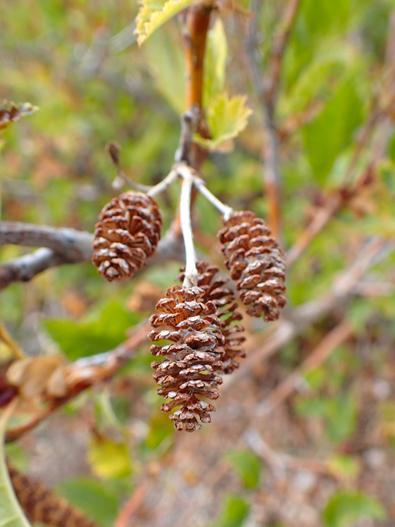Sitka Alder
(Alnus alnobetula subsp. sinuata)
Sitka Alder (Alnus alnobetula subsp. sinuata)
/
/

Krzysztof Ziarnek, Kenraiz
CC BY-SA 4.0
Image By:
Krzysztof Ziarnek, Kenraiz
Recorded By:
Copyright:
CC BY-SA 4.0
Copyright Notice:
Photo by: Krzysztof Ziarnek, Kenraiz | License Type: CC BY-SA 4.0 | License URL: https://creativecommons.org/licenses/by-sa/4.0 | Uploader: Kenraiz | Publisher: Wikipedia Commons














Estimated Native Range
Summary
Alnus alnobetula subsp. sinuata, commonly known as Sitka Alder, Green Alder, or Mountain Alder, is a deciduous shrub or small tree native to the mountainous regions and forest margins of Northern North America, extending from Alaska through western Canada to California and New Mexico. It is particularly adapted to subalpine environments and disturbed areas such as avalanche tracks and riverbanks. Typically, it reaches a height of 9-20 feet (2.7-6 meters) and a width of 6-12 feet (1.8-3.7 meters). This species features catkins with green or yellow flowers that are not particularly showy, blooming in the spring. The bark is smooth and gray, and it produces small, woody cones that persist into winter.
Sitka Alder is valued for its ability to fix nitrogen in the soil, which enhances soil fertility, making it beneficial for reclamation projects and naturalized plantings. It is also used for erosion control due to its fast-growing root system. In cultivation, it is suitable for naturalistic settings, such as wildlife gardens and riparian plantings. This alder prefers full sun to part shade and thrives in medium or fast-draining clay, loam, or sandy soils with consistent moisture. It is relatively low-maintenance but can be susceptible to alder blight and phytophthora root diseases.CC BY-SA 4.0
Sitka Alder is valued for its ability to fix nitrogen in the soil, which enhances soil fertility, making it beneficial for reclamation projects and naturalized plantings. It is also used for erosion control due to its fast-growing root system. In cultivation, it is suitable for naturalistic settings, such as wildlife gardens and riparian plantings. This alder prefers full sun to part shade and thrives in medium or fast-draining clay, loam, or sandy soils with consistent moisture. It is relatively low-maintenance but can be susceptible to alder blight and phytophthora root diseases.CC BY-SA 4.0
Plant Description
- Plant Type: Tree, Shrub
- Height: 9-20 feet
- Width: 6-12 feet
- Growth Rate: Moderate
- Flower Color: N/A
- Flowering Season: Spring
- Leaf Retention: Deciduous
Growth Requirements
- Sun: Full Sun, Part Shade
- Water: Medium
- Drainage: Medium, Fast
Common Uses
Bank Stabilization, Erosion Control, Low Maintenance, Water Garden
Natural Habitat
Mountainous regions and forest margins, particularly in subalpine environments and disturbed areas such as avalanche tracks and riverbanks
Other Names
Common Names: Green Alder, Mountain Alder
Scientific Names: , Alnus alnobetula subsp. sinuata, Alnaster kamtschaticus, Alnaster sinuatus, Alnus alnobetula var. stenophylla, Alnus crispa subsp. laciniata, Alnus crispa subsp. sinuata, Alnus crispa var. laciniata, Alnus crispa var. sinuata, Alnus fruticosa subsp. kamtschatica
GBIF Accepted Name: